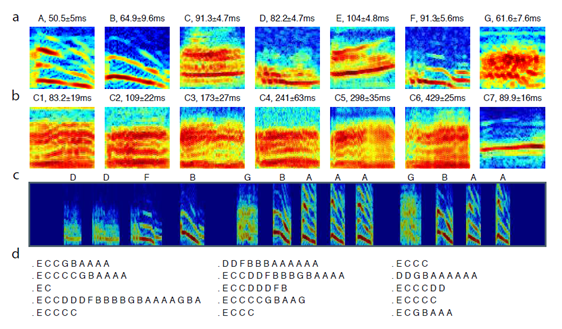Scientists Decode Birdsong
One of the great challenges in neuroscience is to explain how collections of neural circuits produce the complex sequences of signals that result in behaviours such as animal communication, birdsong and human speech.

Among the best studied models in this area are birds such as zebra finches. These enthusiastic singers produce songs that consist of long but relatively simple sequences of syllables. These sequences have been well studied and their statistical properties calculated.
It turns out that these statistical properties can be accurately reproduced using a type of simulation called a Markov model in which each syllable is thought of as a state of the system and whose appearance in a song depends only on the statistical properties of the previous syllable. Such a model implies that there is a one-to-one mapping between each syllable and the neural circuit that generates it.
But other birds produce more complex songs and these are harder to explain. One of these is the Bengalese finch whose songs vary in seemingly unpredictable ways and cannot be explained a simple Markov model. Just how the Bengalese finch generates its song is a mystery.
Until now. By a strange coincidence, two papers appear on the arXiv this week putting forward similar explanations for the Bengalese finch’s ability. One team is led by Kentaro Katahira at the University of Tokyo and the other by Dezhe Jin at Pennsylvania State University. Both groups say they have decoded the statistical secrets in Bengalese finch song and have developed models that can reproduce it.
The first part of their work involved locking Bengalese finches in sound-proofed rooms and recording their songs for a few days.
Next, they locked some poor postdoc in a room until he or she manually annotated each recorded syllable. Then the statistical properties of the birdsong were worked out–how each syllable depends not only on the preceding syllable but on the various notes before that too.
With the statistics revealed, the final task was to find some way of reproducing them.
Both teams have come up with models that have a crucial difference from standard Markov models. Instead of the simple one-to-one mapping between syllable and circuit that explains zebra finch song, they say that in Bengalese finches there is a many-to-one mapping, meaning that a given syllable can be produced by several neural circuits. That’s why the statistics are so much more complex, they say.
This type of model is called a hidden Markov model because the things that drives the observable part of the system–the song–remains hidden. And it can reproduce all kinds of previously mysterious features of Bengalese finch song such as the pattern of repeated sequences, the probability of observing a given syllable at a given step from the start, and the distribution of N-grams or sequences of n syllables.
That’s a significant result. It means that scientists have finally decoded complex birdsong for the first time.
The question now is how to extend the result to describe the statistical properties of other more complex animal behaviours. Obvious candidates include whale song and dolphin vocalisation. Beyond that, the statistics of human speech represent a tempting challenge.
Refs:
arxiv.org/abs/1011.2998: A Compact Statistical Model Of The Song Syntax In Bengalese Fifinch
arxiv.org/abs/1011.2575: Complex Sequencing Rules Of Birdsong Can Be Explained By Simple Hidden Markov Processes
Keep Reading
Most Popular
Large language models can do jaw-dropping things. But nobody knows exactly why.
And that's a problem. Figuring it out is one of the biggest scientific puzzles of our time and a crucial step towards controlling more powerful future models.
How scientists traced a mysterious covid case back to six toilets
When wastewater surveillance turns into a hunt for a single infected individual, the ethics get tricky.
The problem with plug-in hybrids? Their drivers.
Plug-in hybrids are often sold as a transition to EVs, but new data from Europe shows we’re still underestimating the emissions they produce.
Stay connected
Get the latest updates from
MIT Technology Review
Discover special offers, top stories, upcoming events, and more.